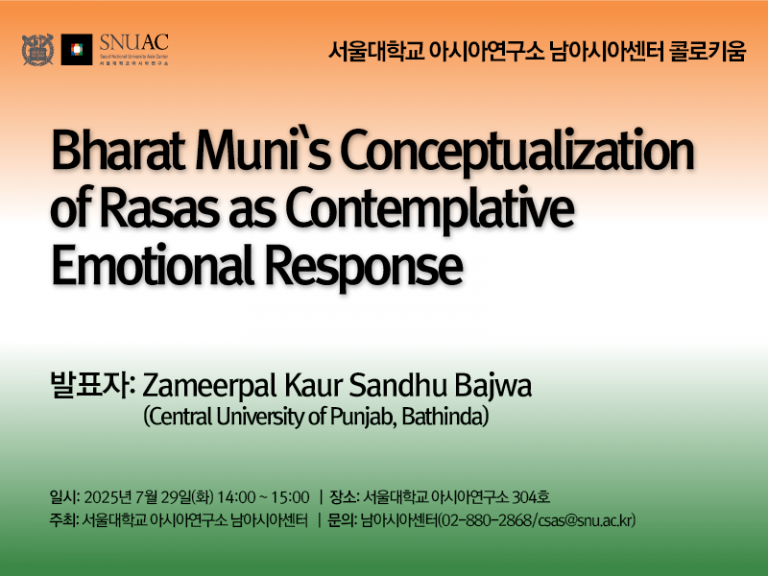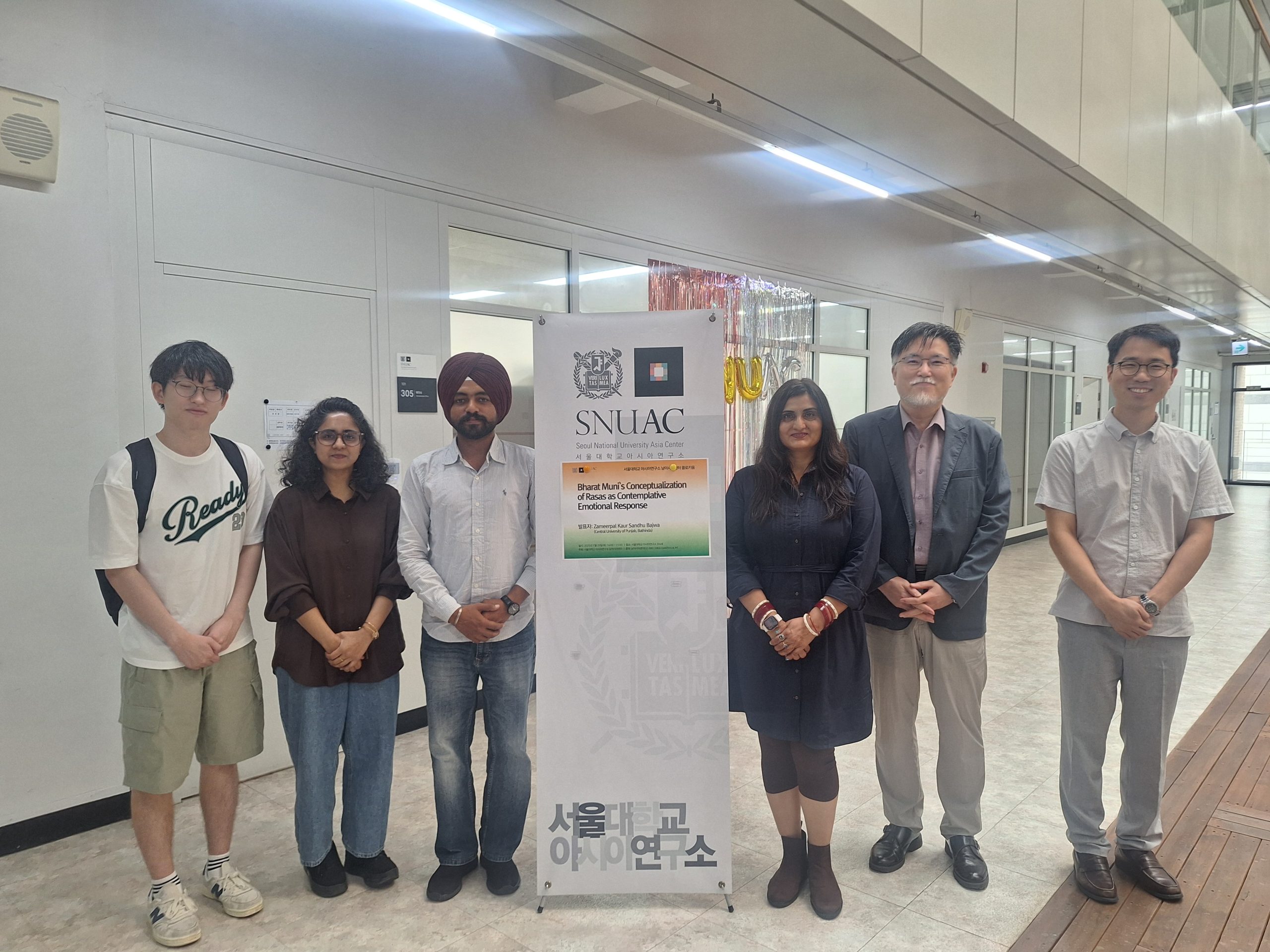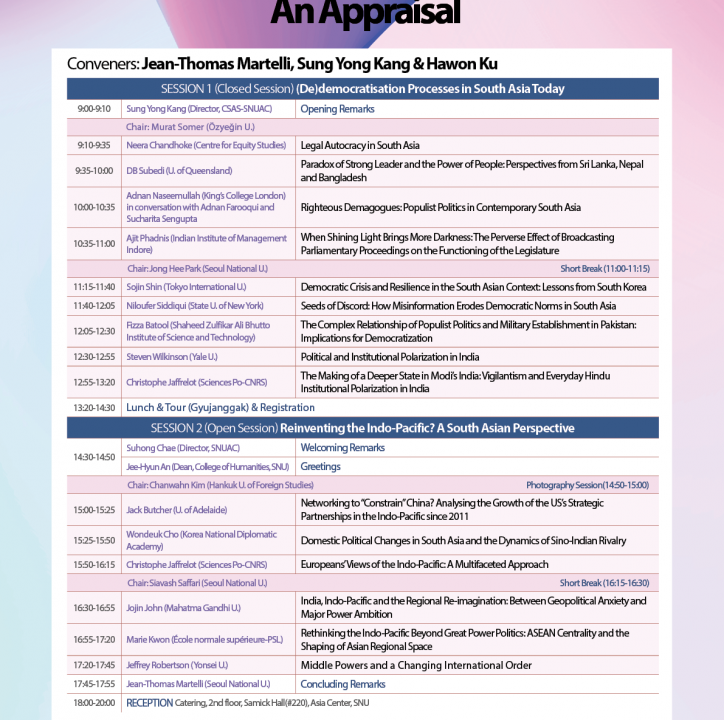- Center for South Asian Studies
- 02-880-2868
- csas@snu.ac.kr
Bharat Muni’s Conceptualization of Rasas as Contemplative Emotional Response

Projecting Demos and Kratos in South Asia: An Appraisal
July 16, 2025
제 7기 남아시아문화학교
September 26, 2025India has a very rich tradition of aesthetics and poetics developed in Sanskrit language. Beginning from Bharta Muni (between 200 BC – 200 CE approx.) to Panditraj Jagan Natha in the 17th Century, it spreads over almost two thousand years. Bhartmuni propounds his theory of Rasa through his famous work Natyashastra. Indian thinking on aesthetics is inclusive and cumulative, not fragmented. The word Rasa literally means the flavor, essence, juice, or taste but metaphorically, it means aesthetic relish or aesthetic pleasure realised during the reading of a text or witnessing of a piece of art. From Indian perspective, a work of art is considered aesthetic, only if it stimulates the senses of the reader and provides pleasure. Aesthetic pleasure is gained through appealing the ‘emotion’ of a reader to realise a particular aesthetic experience, called Rasa, and here the ‘emotions’ involved are called Bhavas. So, Rasa is an essential element of any work of art that can only be suggested, not described. Bharta Muni has identified eight permanent emotions or bhavas as love, anger, sorrow, fear, disgust, wonder, enthusiasm, and humor linked to eight particular Sthayi Bhavas or permanent moods, giving rise to eight particular Rasas. Finally, realisation of Rasa ensues from the union of three interrelated elements – Vibhava (determinants or causes), Anubhava (consequents) and Vyabhchari Bhavas (transitory emotions). In the present talk, I am going to discuss as to how the theory of rasa essentially deals with different kinds of emotions, and how they are depicted, inferred and transmitted through a work of art, especially drama.
발표자 소개
Professor (Dr.) Zameerpal Kaur Sandhu Bajwa is a scholar of Punjabi literature and comparative literary theory, currently serving as Professor in the Department of Punjabi and Director of the Interdisciplinary Centre for Languages and Literary Studies at the Central University of Punjab. She holds a doctorate from Punjabi University, Patiala. Her research spans interdisciplinary studies, Indian poetics, ecocriticism, and Punjabi folklore. Fluent in multiple languages and scripts, she integrates classical and contemporary approaches in her literary analysis. Her recent work focuses on the intersection of aesthetics, environment, and affect in South Asian traditions. In this lecture, she examines Bharat Muni’s theory of rasa as a contemplative emotional experience, drawing from Sanskrit poetics and religious epistemology.
Photos
Review
2025년 7월 29일, 아시아연구소 남아시아센터에서는 Central Univserity of Punjab, Bathinda 교수인 Zameerpal Kaur Sandhu Bajwa를 초청하여 인도의 미학이론에 대한 콜로키움을 개최하였다. 강연자는 『나뜨야샤스트라』에서 바라타 무니가 제시한 라사 이론을 중심으로 인도 미학의 핵심 개념을 조명하였다. 라사는 예술적 감상 과정에서 발생하는 정서적 몰입과 미적 희열로, 창작자-작품-관객 사이의 역동적 상호작용을 통해 실현된다고 설명되었다. 특히 인간 감정의 세계인 ‘바바-자갓(Bhava-Jagata)’을 토대로 감정이 라사로 전환되는 과정을 강조하였다. 드라마는 일상의 감정을 예술로 승화시키며 관객에게 내적 일체감과 신적 환희를 제공하는 수단으로 이해되었다. 본 강연은 고전 미학이 현대 감정 및 인지 연구와 어떻게 연결될 수 있는지를 시사하며, 예술 체험의 깊이를 다시금 성찰하게 하였다.





